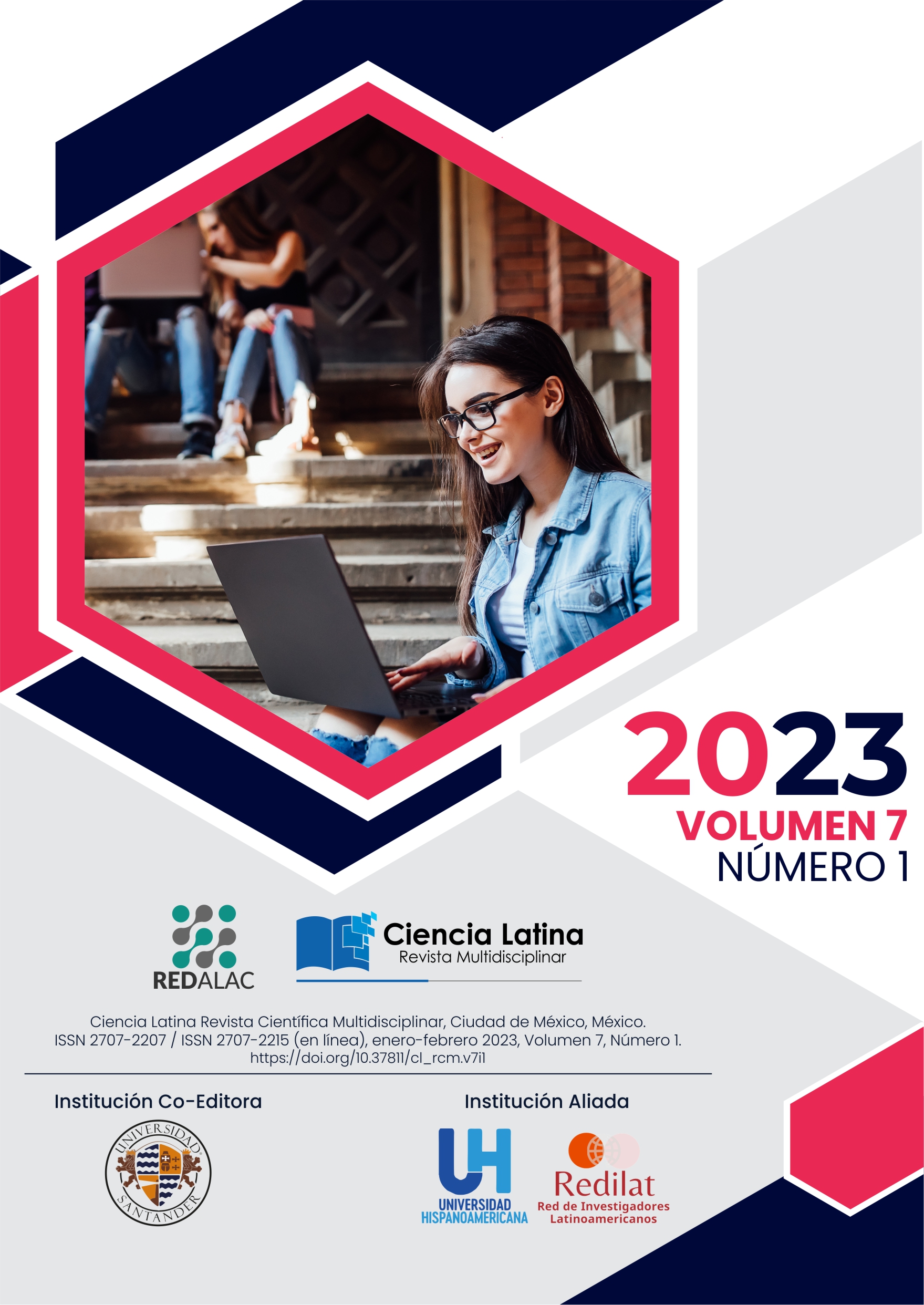Diagnóstico y tratamiento del hematoma subdural crónico
Resumen
GENERALIDADES: El hematoma subdural crónico es considerado como una patología neuroquirúrgica frecuentemente en pacientes de edad avanzada que superan los 65 años, aunque también puede desarrollarse en niños y adultos jóvenes. Esta patología es una afección secundaria a un trauma craneoencefálico que se acompaña de síntomas como: dolor de cabeza, deterioro cognitivo, alteración de la marcha o debilidad motora. OBJETIVO: Realizar una búsqueda bibliográfica sobre características clínicas, fisiopatología que provoca los síntomas y el tratamiento del hematoma subdural crónico. METODOLOGÍA: El presente es un artículo de revisión bibliográfica, descriptivo, retrospectivo, en el cual se realizará una búsqueda exhaustiva clásica y contemporánea (de los últimos 5 años publicados) de artículos científicos, libros, tesis doctorales disponibles en diferentes bases de datos académicos en el área de la medicina acerca el hematoma subdural crónico, para describir el origen, las causas características clínicas, métodos de diagnóstico y manejo terapéutico de esta patología. RESULTADOS: Las características del hematoma subdural crónico varían de acuerdo con la gravedad y ubicación del hematoma, puede ser originado por: la avanzada edad, medicamentos anticoagulantes, enfermedades cerebrales, abuso de alcohol etc. CONCLUSIONES: Buscar atención médica especializada en el caso de presentar algún síntoma debido a que el diagnóstico temprano puede prevenir complicaciones graves a la salud de los pacientes.
Descargas
Citas
Baiser, D., Farooq, S., Mehmood, T., Reyes, M., & Samadani, U. (2015). Actual and projected incidence rates for chronic subdural hematomas in United States Veterans Administration and civilian populations. Journal of Neurosurgery, 123(5), 1209–1215. https://doi.org/10.3171/2014.9.JNS141550
Ban, S. P., Hwang, G., Byoun, H. S., Kim, T., Lee, S. U., Bang, J. S., Han, J. H., Kim, C. Y., Kwon, O. K., & Oh, C. W. (2018a). Middle meningeal artery embolization for chronic subdural hematoma. Radiology, 286(3), 992–999. https://doi.org/10.1148/RADIOL.2017170053
Castro-Rodríguez, C., Román-Pena, P., Arán-Echabe, E., & Gelabert-González, M. (2016). Hematoma subdural crónico en pacientes muy ancianos. Revista Española de Geriatría y Gerontología, 51(6), 309–316. https://doi.org/10.1016/J.REGG.2016.05.003
Chihara, H., Imamura, H., Ogura, T., Adachi, H., Imai, Y., & Sakai, N. (2014). Recurrence of a Refractory Chronic Subdural Hematoma after Middle Meningeal Artery Embolization That Required Craniotomy. NMC Case Report Journal, 1(1), 1–5. https://doi.org/10.2176/NMCCRJ.2013-0343
Clínicos, C., Gonzalo, I., Olivares, T., & Marcelocallisaya Villacorta, M. (n.d.). EMPIEMA SUBDURAL: SERIE DE CASOS Y REVISIÓN DE LA LITERATURA. Rev Med La Paz, 1, 25.
Delgado-López, P. D., Martín-Velasco, V., Castilla-Díez, J. M., Rodríguez-Salazar, A., Galacho-Harriero, A. M., & Fernández-Arconada, O. (2009). Dexamethasone treatment in chronic subdural haematoma. Neurocirugía, 20(4), 346–359. http://scielo.isciii.es/scielo.php?script=sci_arttext&pid=S1130-14732009000400003&lng=es&nrm=iso&tlng=en
Edlmann, E., Holl, D. C., Lingsma, H. F., Bartek, J., Bartley, A., Duerinck, J., Jensen, T. S. R., Soleman, J., Shanbhag, N. C., Devi, B. I., Laeke, T., Rubiano, A. M., Fugleholm, K., van der Veken, J., Tisell, M., Hutchinson, P. J., Dammers, R., Kolias, A. G., Edlmann, E., … Verbaan, D. (2020c). Systematic review of current randomised control trials in chronic subdural haematoma and proposal for an international collaborative approach. Acta Neurochirurgica, 162(4), 763–776. https://doi.org/10.1007/S00701-020-04218-8
Fiorella, D., & Arthur, A. S. (2019a). Middle meningeal artery embolization for the management of chronic subdural hematoma. Journal of NeuroInterventional Surgery, 11(9), 912–915. https://doi.org/10.1136/NEURINTSURG-2019-014730
Fuenmayor Duche, T. C., Quintanilla González, A. C., Olmedo Cahuasquí, P. J., & Rodríguez Rodríguez, M. L. (2020). Hematoma subdural crónico : tratamiento. Recimundo, 4(3), 184–198. https://doi.org/10.26820/recimundo/4.(3).julio.2020.184-198
Gómez Vega, J. C., Rojas Q, M. X., Gómez Vega, J. C., & Rojas Q, M. X. (2021c). Hematoma subdural crónico. Una actualización y revisión. Universitas Medica, 62(3), 132–148. https://doi.org/10.11144/JAVERIANA.UMED62-4.HSCA
Guevara Melcón, A., & Obregón Marín, A. (2012). Tratamiento médico de un hematoma subdural crónico. Revista Cubana de Cirugía, 51(1), 65–70. http://scielo.sld.cu/scielo.php?script=sci_arttext&pid=S0034-74932012000100008&lng=es&nrm=iso&tlng=es
Hematoma subdural crónico: tratamiento. (n.d.). Retrieved November 20, 2022, from https://redib.org/Record/oai_articulo2756182-hematoma-subdural-cr%C3%B3nico-tratamiento
Hirashima, Y., Kurimoto, M., Nagai, S., Hori, E., Origasa, H., & Endo, S. (2005). Effect of platelet-activating factor receptor antagonist, etizolam, on resolution of chronic subdural hematoma - A prospective study to investigate use as conservative therapy. Neurologia Medico-Chirurgica, 45(12), 621–626. https://doi.org/10.2176/NMC.45.621
Iftikhar, M., Siddiqui, U. T., Rauf, M. Y., Malik, A. O., & Javed, G. (2016). Comparison of Irrigation versus No Irrigation during Burr Hole Evacuation of Chronic Subdural Hematoma. Journal of Neurological Surgery, Part A: Central European Neurosurgery, 77(5), 416–421. https://doi.org/10.1055/S-0035-1564049
Janowski, M., & Kunert, P. (2012). Intravenous fluid administration may improve post-operative course of patients with chronic subdural hematoma: A retrospective study. PLoS ONE, 7(4). https://doi.org/10.1371/JOURNAL.PONE.0035634
Jimenez, K. P., & Olazábal, I. (2014). Formas clínicas de presentación del hematoma subdural crónico en el adulto mayor en el Hospital de Quelimane. Revista Cubana De Neurologia Y Neurocirugia, 4(2), 141–146.
Jinhao, H., Chuang, G., Jingfei, D., Jianning, Z., & Rongcai, J. (2020). Drug treatment of chronic subdural hematoma. Expert Opin Pharmacother, 21(4), 435–444. https://doi.org/https://doi.org/10.1080/14656566.2020.1713095
Kim, E. (2017b). Embolization Therapy for Refractory Hemorrhage in Patients with Chronic Subdural Hematomas. World Neurosurgery, 101, 520–527. https://doi.org/10.1016/J.WNEU.2017.02.070
Lee, L., Ker, J., Ng, H. Y., Munusamy, T., King, N. K. K., Kumar, D., & Ng, W. H. (2016). Outcomes of chronic subdural hematoma drainage in nonagenarians and centenarians: A multicenter study. Journal of Neurosurgery, 124(2), 546–551. https://doi.org/10.3171/2014.12.JNS142053
Lizana, J., Aliaga, N., & Basurco, A. (2021). Chronic subdural hematoma: A common pathology with complex management. Surgical Neurology International, 12, S1–S16. https://doi.org/10.25259/SNI_676_2021
Marbacher, S., Fandino, J., & Lukes, A. (2018). Acute subdural hematoma from ruptured cerebral aneurysm. Acta Neurochirurgica, 152(3), 501–506. https://doi.org/10.1007/s00701-009-0521-0
Martínez, F. (n.d.-a). Presentación clínica del hematoma subdural crónico en adultos: el gran simulador Clínica del Hematoma Subdural Crónico.
Mehta, V., Harward, S., Sankey, E., Nayar, G., & Codd, P. (2018). Evidence based diagnosis and management of chronic subdural hematoma: A review of the literature. Journal of Clinical Neuroscience, 50, 7–15. https://doi.org/https://doi.org/10.1016/j.jocn.2018.01.050
Nanda, A. (2020). Complicaciones en Neurociencia. In Elsevier Health Sciences. Elsevier Health Sciences.
Ng, S., Derraz, I., Boetto, J., Dargazanli, C., Poulen, G., Gascou, G., Lefevre, P. H., Molinari, N., Lonjon, N., & Costalat, V. (2020a). Middle meningeal artery embolization as an adjuvant treatment to surgery for symptomatic chronic subdural hematoma: A pilot study assessing hematoma volume resorption. Journal of NeuroInterventional Surgery, 12(7), 695–699. https://doi.org/10.1136/NEURINTSURG-2019-015421
Oh, H. J., Seo, Y., Choo, Y. H., Kim, Y. Il, Kim, K. H., Kwon, S. M., Lee, M. H., & Chong, K. (2022). Clinical Characteristics and Current Managements for Patients with Chronic Subdural Hematoma: A Retrospective Multicenter Pilot Study in the Republic of Korea. Journal of Korean Neurosurgical Society, 65(2), 255–268. https://doi.org/10.3340/jkns.2021.0138
Ortega Santiesteban, O., Gil Alfonso, M., Bacallao González, L., Hechevarría, J. A., García Díaz, M., & Alonso Gálvez, C. (2019). Diagnóstico del hematoma subdural: un proceso de clínica e imágenes dinámico. Revista Médica Electrónica, 41(2), 1684–1824.
Payer, M., & Agosti, R. (2018). Spontaneous acute spinal subdural hematoma: Spontaneous recovery from severe paraparesis-case report and review. Acta Neurochirurgica, 152(11), 1981–1984. https://doi.org/10.1007/s00701-010-0758-7
Piergallini, L., Dargazanli, C., Derraz, I., & Costalat, V. (2019). Immediate Development of Dural Arteriovenous Fistula After Middle Meningeal Artery Embolization: First Angiographic Demonstration. World Neurosurgery, 128, 606-610.e1. https://doi.org/10.1016/J.WNEU.2019.04.246
Rajah, G. B., Tso, M. K., Dossani, R., Vakharia, K., & Siddiqui, A. H. (2020a). Transradial embolization of the left middle meningeal artery and accessory middle meningeal artery for treatment of subacute-chronic subdural hematoma. Journal of NeuroInterventional Surgery, 12(4), 436. https://doi.org/10.1136/NEURINTSURG-2019-015493
Rauhala, M., Helén, P., Huhtala, H., Heikkilä, P., Iverson, G. L., Niskakangas, T., Öhman, J., & Luoto, T. M. (2020). Chronic subdural hematoma—incidence, complications, and financial impact. Acta Neurochirurgica, 162(9), 2033–2043. https://doi.org/10.1007/s00701-020-04398-3
Sun, T. F. D., Boet, R., & Poon, W. S. (2005). Non-surgical primary treatment of chronic subdural haematoma: Preliminary results of using dexamethasone. British Journal of Neurosurgery, 19(4), 327–333. https://doi.org/10.1080/02688690500305332
Vacca, V. M., & Argento, I. (2019). Hematoma subdural crónico: una complicación frecuente. Nursing, 36(1), 16–23. https://doi.org/10.1016/J.NURSI.2019.01.007
Veiga de Cabo, J., De la Fuente Díez, E., & Zimmermann Verdejo, M. (2008). Modelos de estudios en investigación aplicada: conceptos y criterios para el diseño. Medicina y Seguridad Del Trabajo, 54(210), 81–88. https://doi.org/10.4321/s0465-546x2008000100011
Wang, H., Wang, C., & Li, Z. (2020). Recurrent Bilateral Chronic Subdural Hematoma After Interventional Embolization Combined With Drilling and Drainage Treatment. The Journal of Craniofacial Surgery, 31(2), e171–e173. https://doi.org/10.1097/SCS.0000000000006128
Waqas, M., Vakhari, K., Weimer, P. v., Hashmi, E., Davies, J. M., & Siddiqui, A. H. (2019). Safety and Effectiveness of Embolization for Chronic Subdural Hematoma: Systematic Review and Case Series. World Neurosurgery, 126, 228–236. https://doi.org/10.1016/J.WNEU.2019.02.208
Yesil, S., Tanyildiz, H. G., & Sahin, G. (2016). How should we monitor boys with testicular microlithiasis? Pediatric Hematology and Oncology, 33(3), 171–177. https://doi.org/10.3109/08880018.2016.1156203
Derechos de autor 2023 Lucio Parra Lisseth Jackeline; Ángel Geovanny Romo López

Esta obra está bajo licencia internacional Creative Commons Reconocimiento 4.0.













.png)




















.png)
1.png)


